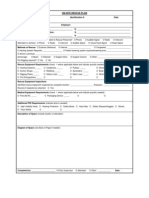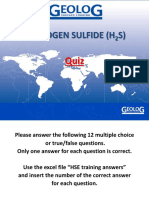Confined Space Entry
Confined Space Entry
Uploaded by
geo_hazreqCopyright:
Available Formats
Confined Space Entry
Confined Space Entry
Uploaded by
geo_hazreqOriginal Description:
Copyright
Available Formats
Share this document
Did you find this document useful?
Is this content inappropriate?
Copyright:
Available Formats
Confined Space Entry
Confined Space Entry
Uploaded by
geo_hazreqCopyright:
Available Formats
Confined Space Entry
Safe Work Practices and Procedures
SWPP-005
Page 1 of 3
Health and Safety Hazards
Chemical hazards; gases, vapours, dust, solvents, fumes and mists.
Physical hazards; noise, temperature, air quality and illumination.
Biological hazards; fungus, molds and parasites.
Ergonomic hazards; awkward postures.
Machine hazards; moving machinery parts and hot parts.
Energy hazards; electricity, heat, gravity and kinetic.
Confined space hazards; restricted entry/exit and hazardous atmosphere.
Work practice hazards; following established safe work practices and
procedures.
Safe Work Practices
After January 1, 2013 only workers who have completed a confined space
entry program are permitted to work in a confined space.
Refer to the Confined Space Entry Program for additional information.
A confined space should be considered hazardous unless determined
otherwise by a comprehensive hazard assessment.
Workers who have to work in confined spaces must be advised of the
existence of and dangers posed by confined spaces.
Workers are not permitted to enter or remain in a confined space that
contains or is likely to contain an explosive or flammable gas or vapour.
Do not enter a confined space if a new hazard is present that was not
identified by the initial hazard assessment.
Do not create an obstruction by storing materials near or adjacent to a
confined space access/egress.
Safe Work Procedure
1. Identifying Confined Space
Determine if the space is considered a confined space as per the
OH&S legislation (i.e. not designed or intended for human occupancy
except for the purpose of performing work, has restricted access/egress
and may become hazardous to a person entering it).
Ensure the confined space is clearly identified with appropriate signage.
2. Hazard Assessment
A worker is not permitted to enter a confined space until a person with
adequate knowledge, training and experience has completed a formal
hazard assessment and the Confined Space Hazard Assessment Form.
Approved By: Directors of Facilities, and Policy and Facilities Planning
Date Approved: March 1, 2012
Date of Amendments:
Confined Space Entry
Safe Work Practices and Procedures
SWPP-005
Page 2 of 3
Where two or more confined spaces are of similar construction and
present the same hazards, their hazard assessments may be recorded
in a single Confined Space Hazard Assessment Form.
3. Air Monitoring
There must be appropriate tests for harmful substances and oxygen
deficiency before entry into a confined space, after an interruption in the
work procedure and at appropriate intervals.
Tests must be performed by a worker who has been adequately trained.
If a test indicates an unsafe condition, then the confined space must be
ventilated or cleaned or both and periodically retested.
Test results must be recorded on the entry permit form.
4. Entry Permit
A worker is not permitted to enter a confined space without a valid entry
permit.
The completed and signed entry permit must be posted at the entry
portal to the confined space.
If a hazard assessment has been completed of a representative sample
of identical confined spaces, then a single entry permit can be used for
these and any other identical confined spaces.
5. Hot Work Permit
If hot work is involved in the confined space, then a special hot work
permit must be obtained from the respective maintenance supervisor.
6. Attendant and Entrant Responsibilities
Attendant is required to;
o Remain alert at all times outside and near the entrance.
o Monitor the safety of the entrant in the confined space.
o Provide assistance to the entrant.
o Maintain continuous 2-way communication with the entrant.
o Initiate an emergency response when necessary. Perform nonentry emergency rescue if safe to do so.
Entrant is required to;
o Remain alert at all times while working in the confined space.
o Be aware of all potential hazards in the confined space.
o Be aware of any symptoms or warning signs of exposure.
o Immediately report any concerns to the attendant.
o Immediately exit the confined space if conditions warrant it, an
alarm sounds or if directed to do so.
Approved By: Directors of Facilities, and Policy and Facilities Planning
Date Approved: March 1, 2012
Date of Amendments:
Confined Space Entry
Safe Work Practices and Procedures
SWPP-005
Page 3 of 3
7. Communications
The attendant and entrant must be in continuous communication with
each other.
The attendant must be provided with a communication device for
summoning an adequate rescue response.
8. Implementation of Hazard Controls
Identified hazards must be properly controlled by implementing
appropriate control methods.
Workers must ensure their PPE is in good working condition and is
suitable for the type of work to be performed.
A full body harness with a lifeline must be worn if a harmful atmosphere
exists or may develop, or where entrapped is possible.
Refer to the Respiratory Protection Program if a respirator is required.
9. Entry into a Confined Space
A worker is permitted to enter a confined space only where;
o The opening is sufficient to allow safe passage of a worker;
o Mechanical equipment in the confined space is locked out;
o Pipes and other supply lines are blanked off;
o Measures have been taken to ensure that, where appropriate, the
confined space is continuously ventilated;
o A liquid or free-flowing solid has been removed;
o Explosion-proof illumination is provided where appropriate; and
o Adequate barriers are erected to prohibit unauthorized entry.
10. Emergency Rescue
Rescue procedures must be established and reviewed prior to any
worker entering a confined space.
If rescue is required the attendant must immediately notify rescue
personnel, 911, the local fire department, emergency medical services
and the respective maintenance supervisor.
Rescue personnel, equipment and first aid supplies must be readily
available for the duration of the entry.
Under no circumstances shall the attendant enter the confined space to
perform a rescue.
Approved By: Directors of Facilities, and Policy and Facilities Planning
Date Approved: March 1, 2012
Date of Amendments:
You might also like
- Sydney Safety Confined Space Rescue PlanNo ratings yetSydney Safety Confined Space Rescue Plan4 pages
- 364 Pre Job Check List High Pressure Hydro Jetting Rev 000100% (1)364 Pre Job Check List High Pressure Hydro Jetting Rev 0002 pages
- Brahmaputra Cracker and Polymer Limited Lepetkata, Assam: Job Safety AnalysisNo ratings yetBrahmaputra Cracker and Polymer Limited Lepetkata, Assam: Job Safety Analysis2 pages
- 4-JSA - Unloading Under Inert - F9030 B NewNo ratings yet4-JSA - Unloading Under Inert - F9030 B New6 pages
- Hazard Identification and Risk Assessment For Grit Blasting & CoatingNo ratings yetHazard Identification and Risk Assessment For Grit Blasting & Coating4 pages
- Noise Exposure at Work: Hearing Loss Prevention Rule (Noise) WAC 296-817100% (2)Noise Exposure at Work: Hearing Loss Prevention Rule (Noise) WAC 296-81747 pages
- Kta Alliance Spray /touch Up Painting of Project Materials: Job Safety Analysis (JSA)No ratings yetKta Alliance Spray /touch Up Painting of Project Materials: Job Safety Analysis (JSA)3 pages
- Confined Space Entry Policy: Applicable Doc Um EntsNo ratings yetConfined Space Entry Policy: Applicable Doc Um Ents39 pages
- Environmental, Health and Safety Risks Analysis100% (1)Environmental, Health and Safety Risks Analysis1 page
- AGT - Authorised Gas Tester Interview Q&ANo ratings yetAGT - Authorised Gas Tester Interview Q&A8 pages
- Standard Operating Procedure For Hot Works Operations: PurposeNo ratings yetStandard Operating Procedure For Hot Works Operations: Purpose3 pages
- JSA-RSS-HSE-005 Bristle Blasting, Needle Gun and Painting ActivityNo ratings yetJSA-RSS-HSE-005 Bristle Blasting, Needle Gun and Painting Activity7 pages
- JSA Formet New Structural Steel FabricationNo ratings yetJSA Formet New Structural Steel Fabrication7 pages
- Job Hazard Analysis (Jha) Worksheet: Installation/Facility Job Activity Location Description of Activity Note100% (1)Job Hazard Analysis (Jha) Worksheet: Installation/Facility Job Activity Location Description of Activity Note2 pages
- Safety Alert 49 - Cable Pulling IncidentNo ratings yetSafety Alert 49 - Cable Pulling Incident1 page
- Can Get Medical Assistance.: Deyaar Facilities Management LLC First Aid - Basic - TBT-28No ratings yetCan Get Medical Assistance.: Deyaar Facilities Management LLC First Aid - Basic - TBT-282 pages
- Download full Men and masculinities in the sagas of Icelanders First Edition Evans ebook all chapters100% (2)Download full Men and masculinities in the sagas of Icelanders First Edition Evans ebook all chapters41 pages
- QFR Academy, Live Fire Training Pad Steel Fibre Reinforced Concrete PavementsNo ratings yetQFR Academy, Live Fire Training Pad Steel Fibre Reinforced Concrete Pavements6 pages
- Full Flight Simulators (FFS) Dry Sessions - 27032024No ratings yetFull Flight Simulators (FFS) Dry Sessions - 270320244 pages
- Strategies of Justification in Authoritarian IdeologyNo ratings yetStrategies of Justification in Authoritarian Ideology24 pages
- Amritananda Natha Saraswati - A Note On Sadhana - Antarmukha SamaradhyaNo ratings yetAmritananda Natha Saraswati - A Note On Sadhana - Antarmukha Samaradhya3 pages
- RPA UIpath and Automation Anywhere Developer (Pranay)No ratings yetRPA UIpath and Automation Anywhere Developer (Pranay)3 pages
- PDF Sports Medicine for Sports Trainers 10th Revised edition Edition Sports Medicine Australia download100% (2)PDF Sports Medicine for Sports Trainers 10th Revised edition Edition Sports Medicine Australia download50 pages
- Nysdot Bridge Inspection Manual 2014 PDFNo ratings yetNysdot Bridge Inspection Manual 2014 PDF416 pages
- (TailieuVNU.com) Giáo Trình Hướng Dẫn Giải Các Bài Toán Xác Suất Thống Kê - Đào Hữu HồNo ratings yet(TailieuVNU.com) Giáo Trình Hướng Dẫn Giải Các Bài Toán Xác Suất Thống Kê - Đào Hữu Hồ326 pages
- MSFJ020D - Denso - CPT 1000 Innerwrap and CPT 1000 OuterwrapNo ratings yetMSFJ020D - Denso - CPT 1000 Innerwrap and CPT 1000 Outerwrap7 pages
- Answers For Do Literate Women Make Better Mothers - IELTS Reading Practice TestNo ratings yetAnswers For Do Literate Women Make Better Mothers - IELTS Reading Practice Test3 pages
- Stablization Standards For Outrigger MatsNo ratings yetStablization Standards For Outrigger Mats2 pages

























































































